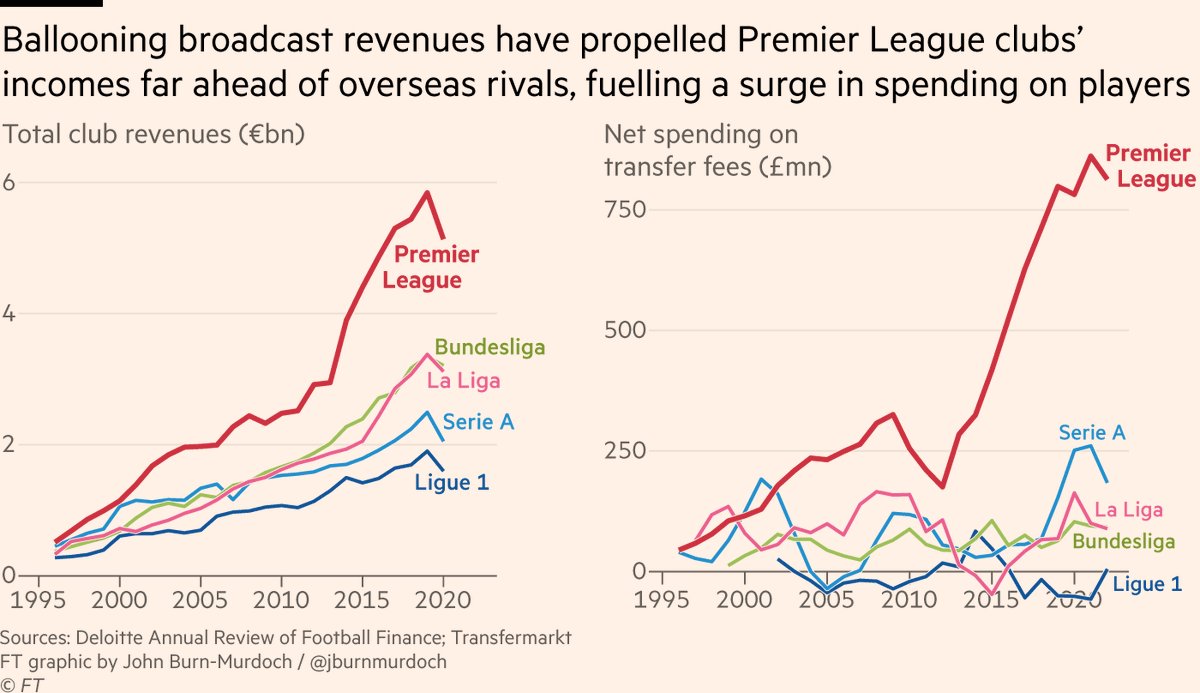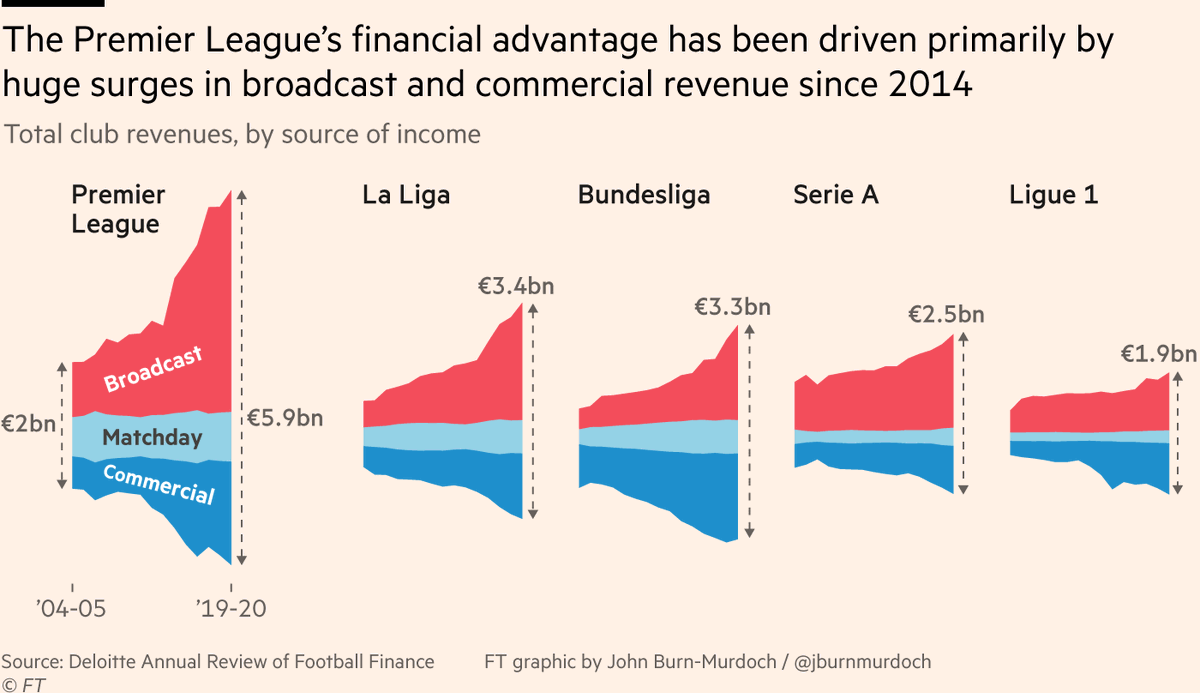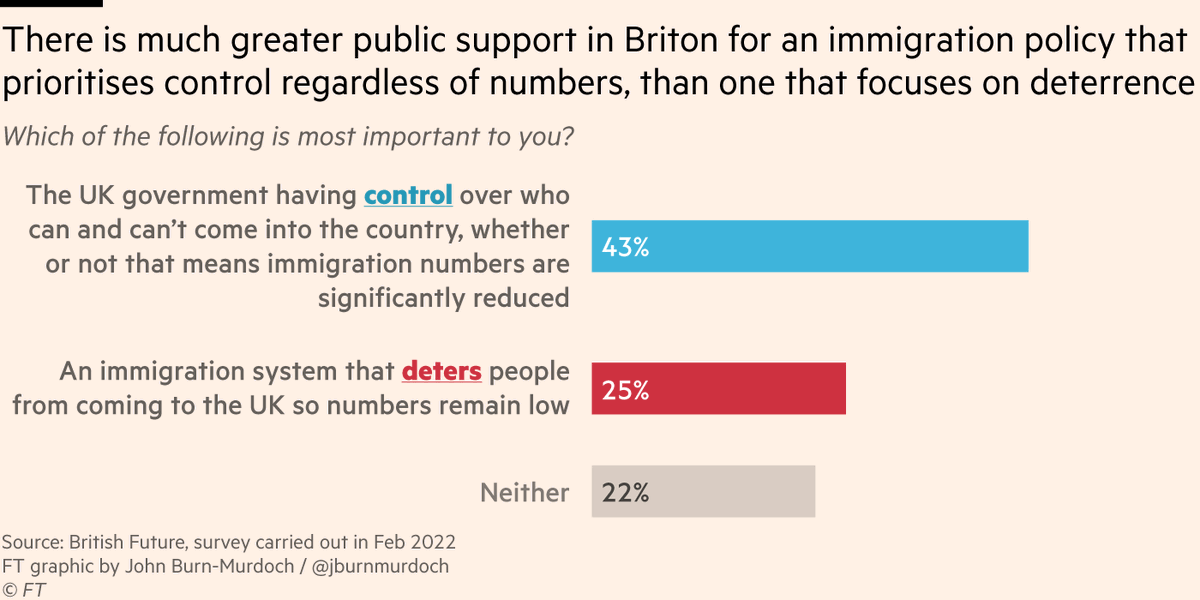
NEW: ahead of Champions League final, we need to talk about financial disparities in football.
For decades the sport has been quietly having its "frog in a pan of water" moment, and it feels like we’re approaching boiling point.
My column ft.com/content/f47279…
And a thread:
For decades the sport has been quietly having its "frog in a pan of water" moment, and it feels like we’re approaching boiling point.
My column ft.com/content/f47279…
And a thread:
Let’s start with a chart:
Premier League clubs’ revenues have been higher than other leagues for decades, but the size of the gap is now vast.
Today the gap is more than €2bn, allowing English sides to comfortably outbid most of their continental rivals on transfers and wages.
Premier League clubs’ revenues have been higher than other leagues for decades, but the size of the gap is now vast.
Today the gap is more than €2bn, allowing English sides to comfortably outbid most of their continental rivals on transfers and wages.

Most of the difference is caused by the Premier League’s much higher broadcast revenues.
This season EPL 🏴 booked £3.1bn for TV rights, vs £1.8bn for La Liga 🇪🇸
Next year the La Liga 🇪🇸 package will dip to £1.6bn, while EPL 🏴 will rise to £3.4bn, according to @Football_BM
This season EPL 🏴 booked £3.1bn for TV rights, vs £1.8bn for La Liga 🇪🇸
Next year the La Liga 🇪🇸 package will dip to £1.6bn, while EPL 🏴 will rise to £3.4bn, according to @Football_BM
Some club-by-club examples are ... eye-opening.
When Inter won the Italian title in 2021, they made around €85mn from Serie A TV money (via @SwissRamble
That same year, Sheffield United received around €115mn for finishing 20th in the Premier League.
When Inter won the Italian title in 2021, they made around €85mn from Serie A TV money (via @SwissRamble
https://twitter.com/SwissRamble/status/1480445312665894914)
That same year, Sheffield United received around €115mn for finishing 20th in the Premier League.
While the bulk of the Premier League’s financial advantage comes from its vast TV deals, commercial revenues also play a big part.
Since the mid 2010s both broadcast and commercial incomes have skyrocketed, far outpacing the other big four leagues.
Since the mid 2010s both broadcast and commercial incomes have skyrocketed, far outpacing the other big four leagues.

And on the commercial side, it’s important to look beneath the surface:
In some instances, what looks like broad-based growth across the league is actually just one club.
Almost all of the apparent growth in commercial € in Ligue 1 is from PSG. On which note...
In some instances, what looks like broad-based growth across the league is actually just one club.
Almost all of the apparent growth in commercial € in Ligue 1 is from PSG. On which note...

We can’t discuss financial disparities and the truly ~incredible~ growth in commercial revenues some clubs have seen without talking about where those revenues come from.
Per @SPIEGEL_English, some commercial incomes are ... less commercial than others spiegel.de/international/…
Per @SPIEGEL_English, some commercial incomes are ... less commercial than others spiegel.de/international/…
Now you might look at all that and say, "okay so some football clubs make a lot more money now. So what?"
The issue is, this money — and who has it — has *completely* transformed the competitive balance of the game, and it’s glaring wherever you look.
The issue is, this money — and who has it — has *completely* transformed the competitive balance of the game, and it’s glaring wherever you look.
Let’s start with the Champions League.
In the early 1990s, clubs from all across Europe routinely reached the semi-finals. We had 13 different countries represented in the semis across 5 years, including clubs from Serbia and Romania.
Today? It’s virtually a closed shop.
In the early 1990s, clubs from all across Europe routinely reached the semi-finals. We had 13 different countries represented in the semis across 5 years, including clubs from Serbia and Romania.
Today? It’s virtually a closed shop.

It’s now exceptional when a club from outside the big five leagues reaches the last-four, and when they do their stars are gobbled up by the superclubs
In a typical season, *three quarters* of UCL semi-finalists now come from just six cities, let alone countries (HT @KuperSimon)
In a typical season, *three quarters* of UCL semi-finalists now come from just six cities, let alone countries (HT @KuperSimon)

Here’s another view of the same data.
In the 5 years ending 1987, *18* different clubs reached the semis, including Steaua București, Dundee United, IFK Göteborg & Widzew Łódź.
Today, it’s a safe bet that 2-3 of this year’s final four will be in next year’s semis, too.
In the 5 years ending 1987, *18* different clubs reached the semis, including Steaua București, Dundee United, IFK Göteborg & Widzew Łódź.
Today, it’s a safe bet that 2-3 of this year’s final four will be in next year’s semis, too.

For all intents and purposes, "European football" now means "Western European football", and even that definition increasingly feels too broad.
On this animation, X marks the epicentre of European footballing prowess. It’s moved steadily west, and is now hovering around Paris.
On this animation, X marks the epicentre of European footballing prowess. It’s moved steadily west, and is now hovering around Paris.
The result of all this is that, as an English club appears in the Champions League final for the fourth time in five years, the risk is that the UCL essentially becomes England’s fourth piece of silverware.
We’ll just assume that the quadruple is a realistic prospect every year.
We’ll just assume that the quadruple is a realistic prospect every year.
And the concentration of money and talent doesn’t just play out between countries, it distorts *within* countries, too.
50 years ago, the best and worst team in the English top tier were separated by 30 pts and 52 goals.
Today? 71 pts and 134 goals.
50 years ago, the best and worst team in the English top tier were separated by 30 pts and 52 goals.
Today? 71 pts and 134 goals.
The geographical shift here is striking ,too.
English football was a ~flat landscape up until the early 1980s. Title winners from the north, south, east, midlands.
Today it’s bimodal. Heaps of money and talent in London and the north-west. Everyone else fighting over scraps.
English football was a ~flat landscape up until the early 1980s. Title winners from the north, south, east, midlands.
Today it’s bimodal. Heaps of money and talent in London and the north-west. Everyone else fighting over scraps.
This is the metaphorical frog in a pan of water
There have been few overnight black-and-white transformations, but after years of incremental increases in inequality, the experience of supporting the average football club in 2022 is unrecognisable from the same in the 70s or 80s
There have been few overnight black-and-white transformations, but after years of incremental increases in inequality, the experience of supporting the average football club in 2022 is unrecognisable from the same in the 70s or 80s
And of course the Premier League is not alone here.
The gap between top and bottom of every one of Europe’s big five leagues is far wider today than in decades past.
(And looking at the shape of that Ligue 1 line, it’s a wonder French fans aren’t on the brink of revolution...)
The gap between top and bottom of every one of Europe’s big five leagues is far wider today than in decades past.
(And looking at the shape of that Ligue 1 line, it’s a wonder French fans aren’t on the brink of revolution...)

Here’s the same thing over time.
Two decades of increasing competitive inequality in almost every league. And no coincidence that the biggest gaps and steepest climbs feature clubs owned by nation states, whose budgets are essentially limitless.
Two decades of increasing competitive inequality in almost every league. And no coincidence that the biggest gaps and steepest climbs feature clubs owned by nation states, whose budgets are essentially limitless.

Wider inequality means far fewer teams — far fewer fans — with a chance of glory.
As recently as mid 1990s, *11 different teams* made
England’s top 4 over 5 years.
Equivalent of Brighton and Wolves fans genuinely harbouring hopes of Champions League qualification next season.
As recently as mid 1990s, *11 different teams* made
England’s top 4 over 5 years.
Equivalent of Brighton and Wolves fans genuinely harbouring hopes of Champions League qualification next season.

This has been a lot of doom and gloom with little upside, and honestly I’m not sure what the optimistic take is.
More money, more eyeballs, more #engagement, I guess.
But that is coinciding with the quiet dismantling of competitive club football.
More money, more eyeballs, more #engagement, I guess.
But that is coinciding with the quiet dismantling of competitive club football.
We celebrated last year when the European Super League collapsed, but the current model is only superficially better.
Sure, at least with the current formats there’s a *theoretical* chance of a superclub dropping out of the elite. But really...?
Sure, at least with the current formats there’s a *theoretical* chance of a superclub dropping out of the elite. But really...?
Let’s be honest: the structures of European club football today are *far* closer to the protectionist, plutocratic model of the Super League than they are to any kind of "socialist" model that was supposedly at risk from the Super League.
And with Saudi Arabia’s purchase of Newcastle only pouring gasoline onto an already-raging fire, the trend is clearly only going to continue.
And finish with @KuperSimon’s piece on the under-discussed story of Real Madrid fandom ft.com/content/3da529…
• • •
Missing some Tweet in this thread? You can try to
force a refresh









